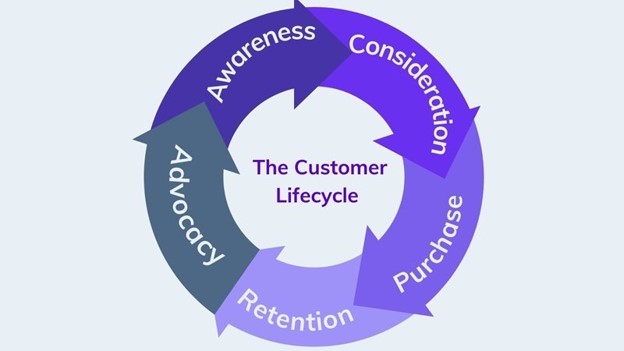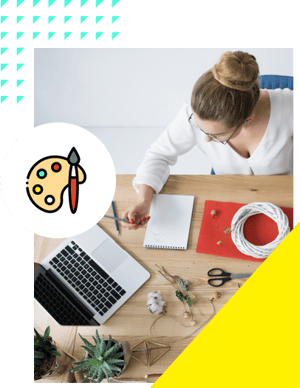Guide
 10 MIN READ
10 MIN READ
The Guide to Understanding the Full E-Commerce Customer Journey
Download This Guide
One of the biggest challenges marketers face is figuring out what type of content to send to email and SMS lists to engage and delight subscribers, while at the same time, avoiding over-communication.
Most companies know the minimum. They send useful information to their sales list or a monthly newsletter to subscribers. Although this is better than nothing, in the long term, the list will start to lose its usefulness because not enough value is being provided to the subscribers.
In the face of these challenges, a few questions arise:
- What type of content should be sent?
- Who should it be sent to?
- How do you create the strategy?
You start with the fundamentals: the e-commerce customer lifecycle.
You can only create a customer-centric strategy if you completely understand your customers. When you do, you can go beyond just sending sales emails and text messages and create a stellar customer experience by providing value to the right person at the right time.
What is the E-Commerce Customer Lifecycle?
The e-commerce customer lifecycle—also referred to as the e-commerce customer journey—is made up of five stages that are based on the psychology and behavior of prospects and customers.

The five stages are:
- Awareness
- Evaluation/Consideration
- Decision
- Retention
- Advocacy
By creating and developing content for each stage of the customer journey, you can witness a significant impact on your sales and revenue. Delivering the right content to the right person at the right time delights your prospects and customers, provides information that is useful to them, and moves them through the customer lifecycle faster.
What’s in it for you? Higher conversion rates, increased revenue, and retained customers.
Let's dive in.
Awareness
Awareness Stage
In the awareness stage, the consumer doesn’t know about your brand. They’re searching for one or both of two things:
- A product or service similar to yours
- Information about a topic, product, or service
In both cases, they’re trying to find the best solution, which means your goal is to increase brand awareness without sales pressure. Instead, you’re showing them what life could be like when they use your brand.
This means that they need to:
- Discover your brand through more organic channels
- Learn about your brand and product with awareness-level content
Three Channels in the Awareness Stage
The awareness stage begins as soon as the consumer begins their online search to find the product or service they are looking for.
This usually happens through organic search, which takes place on web search engines, such as Google or YouTube. The query results are calculated algorithmically and unaffected by advertiser payments. Users perform search functions using SEO keywords to find helpful resources.
Consumers might also search for their product in online marketplaces, such as Amazon or Etsy. Product and service information is held on these e-commerce websites and provided by multiple third parties.
Consumers can also find their products through paid media and paid social. Both of these approaches involve a paid advertisement placement. Advertising is directed to the consumer primarily based on their demographic information (such as age, race, and gender) and online activity (such as current and past search queries, website visits, and previous interactions with ads).
Useful Types of Awareness Stage Content
Through these channels, the consumer will discover awareness level content that is informative, educational, and entertaining.
It’s important that you’re not yet selling your product or service at this stage but rather providing information that’s going to tell them about your product, service, and brand, or a topic that’s similar to your offerings.
This is part of inbound marketing, a methodology that has been championed by brands such as HubSpot and attracts customers with valuable content and experiences tailored to them.
Awareness stage content looks like:
- Blog posts. Articles, news pieces, or guides published on the blog section of a website cover topics or queries that are educational. Though they are primarily text-based, they can contain other media types, such as images, infographics, videos, and interactive charts.
- Social media posts. Content created and posted to a company’s social media profile provides an opportunity to share information, lead a user to the business’s website, and directly interact with a customer and prospect base. You can use platforms such as Gatsby to help scale your social community.
- Educational or entertainment videos. Video-based content provides an opportunity to share interesting, educational information with all its features, such as voice, music, and visuals to engage the viewer.
- Podcasts. With an ongoing series on a topic related to your industry, podcasts provide an opportunity to create candid conversations and build community around your brand.
- Social media ads. Delivering paid ads to your target audience is a quick and effective way to connect with consumers and boost your marketing campaigns.
- Website content. As soon as the user arrives at your website, you can keep them engaged with conversational quizzes and surveys by using third-party software such as Octane to help customize the customer journey.
Evaluation / Consideration

The evaluation and consideration stage begins with the following signs:
- The consumer has moved from “just browsing” to showing interest in a specific product or solution.
- They have narrowed down their choices but still seek more information on those specific choices.
- They are comparing your product to other brands’ products.
At this stage, your goal has shifted from making the consumer aware to building trust with them so that your product moves to the top of the list of solutions that can solve their problem.
The prospects will be looking at:
- Price
- Customer reviews
- Competitor comparisons
- Anything else that aligns with their goals
They could also reach out directly to someone for more information, join your email marketing list, or interact with you on social media channels. Through each of these channels, your job is to build trust by creating relevant content.
To do so, it’s important to understand your audience:
- What questions will they ask before purchasing your product?
- What questions should you ask to create content that builds trust?
Keep in mind that this stage is not about pushing your product. You’re still creating informative, interesting content that positions your brand as the best option.
How Do You Know if Your Prospect is in the Evaluation/Consideration Stage?
Because the lines between stages can sometimes blur, let’s take a look at some of the ways you can be sure they’re in the evaluation/consideration stage.
Over anything else, prospects in this stage want more information. So if you have the right analytics tooling, you can see that they’re spending time on informative areas of your website:
- FAQ page
- “About Us” company page
- Product video explainers, a comparison infographic, or any type of content that is informational in nature
You should also formulate a set of questions that will help you gain further information to ensure these pages are providing the right information for consumers in this stage.
Questions to Ask Yourself and Your Audience
Before we dive into content ideas, let’s consider a handful of important questions that your prospects are probably asking themselves (even if they aren’t asked directly).
Questions You Should Ask While Creating Your Content
- Are the benefits of my product clear? In short, informative tidbits—usually located on the product page of your website—tell your audience about how your product will make their lives better than if they were to go with a different brand.
- Are there multiple ways for a prospect to talk with customer service? While some prefer a live agent, this isn’t always possible. Consider implementing chatbots into your website so visitors can quickly and easily have their questions answered.
- Is the price point of my product competitive with similar businesses? You want to strike a perfect balance between setting competitive prices that align with value and providing the premium product on the market.
- Is there a story behind the product that can help build trust? People choose to work with businesses for a number of factors related to trust. A great customer experience goes beyond services and into a personal connection with the brand that can be gained through excellent brand storytelling.
Questions Your Prospects Are Asking
- What are others saying about the product or brand? People trust reviews, so one of the first things they want to know is about others’ experiences when doing business with you. You should dedicate a section of your website to encouraging customer reviews.
- Does this product solve my pain points? You can get ahead of this question by doing extensive customer research to learn about your personas’ common pain points.
- How will this product save me time or money? This can be answered with a strategy that offers coupons or discounts with a first purchase. You can also add a comparison of competitors’ pricing if it’s available.
- How can I further educate myself to know if this is the right product? Be sure to answer this question with readily available information about the product on both the product page and your blog.
Channels in the Evaluation/Consideration Stage
Leveraging both email and SMS messaging allows you to reach customers where they are. Who doesn’t check their phone or their email multiple times a day?
Platforms such as Klaviyo are useful tools for both email and SMS delivery, and many can expand into social media and live or automated chat.
However, in order to send your subscribers content, you need a strategy that allows you to capture their email or phone number. You can do this with:
- Pop-ups. If a prospect is on your website for the first time, offer a pop-up that encourages them to sign up to receive special offers in exchange for their email address. Justuno is a widely used platform that provides pop-ups (and other features) to convert more website traffic into customers with personalized on-site messaging.
- Valuable content. As they explore your website, make sure the content on each page is informative and engaging.
- Discounts. Offer a discount code—either through a pop-up or on a section of your website—so that they’re more encouraged to move into the decision stage.
Useful Types of Evaluation/Consideration Content
The customer is evaluating your brand and comparing it to others, which means the content you offer in this phase needs to be encouraging and engaging without being too sales-y.
They also want to know how your product works, what the experience has been like for other customers, and what sets you apart from similar brands. Below are a few examples of content that can give them this info:
- Case study. Show your prospective customers how satisfied past customers have been with your product. Fill case studies with quotes from satisfied customers so prospective customers can get a real sense of what it’s like working with you.
- Product demo. Take the prospective customer through the step-by-step process of how to use your product. People don’t want to spend hours learning a new product, so be sure to emphasize its ease of use.
- Sample products. Provide sample products to give prospective customers a “taste” of your product. No credit cards, no buyer’s remorse—just a great opportunity to try your product, no strings attached.
- FAQs. Answer your customers' questions before they ask them. This way, they’re not just benefiting from a stronger understanding of your product, but they’re also gaining trust in your brand.
- Product or educational webinar. Host a webinar (and make sure to record it to post to your website!) that puts a face to your brand. The prospect doesn’t just gain knowledge of your product; they get to see a friendly face as well.
- How-to videos. No one likes to buy a product and not know how to use it. Get a step ahead by reassuring the prospect that they have resources to turn to when they need them.
- Podcast. Many brands are now starting their own podcasts related to their niche market, providing candid conversations and useful information.
- Product comparison guide. Prove to the prospect that you’re the best solution to their problem by comparing pricing, value, and more to other leading competitors.
- Live chat or automated chatbots. Don’t leave your customers hanging when live chat isn’t available. An automated chatbot answers a select number of questions and guides the prospect to helpful pages around the clock. Gorgias is an e-commerce helpdesk that turns your customer service into a profit center through live chat (among other features).
- Surveys. Ask the customer about their problems so you can better deliver information to them while also learning more about your target audience by using Octane.
Decision
After conducting enough research to feel informed about which products can meet their needs and what companies they can trust, your prospective customer has now decided they are ready to select from their options and make a purchase.

Your goal? Convert potential customers into buyers.
It’s crucial that you start showcasing current customer experiences with reviews, user-generated content, and video testimonials. According to research conducted at the Medill Spiegel Research Center out of Northwestern University, past customers—usually through online reviews—have a major and positive influence on sales. Be sure to check out Okendo and Stamped, two highly useful platforms that help companies build trust with customers through reviews.
But good experiences aren’t the only thing you need at this phase. Let’s revisit the buyer persona and the factors that will push them over the edge.
How Do You Know a Prospect is in the Decision Stage?
In the previous section, we briefly discussed using an analytics tool that allows you to see where visitors are interacting with your website.
When a prospect is in the decision stage, they are most likely visiting:
- Case studies
- Testimonials
- A pop-up to sign up for a coupon
To ensure this content is meaningful for them, you should gear the messaging so it’s mainly focused on encouraging them to make a decision while still informing and delighting.
It’s also possible that the prospect will interact with a chatbot. After asking them questions and keeping them engaged with useful content, you’ll want to follow up with them via email.
Similar to sales, it can take several touch points before they convert into a buyer. Incorporate them into email flows or text messaging campaigns that nurture them with relevant content. For example:
- A welcome email flow could have up to 10 emails in it.
- In each email, a different strategy is used to encourage conversion through coupons, engaging content, or inclusion of products similar to those they have been viewing on your product page.
If they purchase, they are removed from this email flow.
Useful Content to Convert in the Decision Stage
Your No. 1 goal at this stage is to help your prospects convert. With useful content and offerings, you can make this happen by:
- Addressing customer objections
- Standing out from the competition
- Offering special services, such as free returns, free shipping, or a risk-free trial
- Providing content that proves the product does exactly what it promises
- Offering free demos or samples
- Providing specific information about the products, such as dimensions, shipping times, pricing, shipping info, warranty information, and product literature
- Listing press releases, FAQs, and consumer reports
With each piece of content, you should make the move to purchase easy with a clear call to action.
You can encourage purchasing and reduce friction by testing various offers. For instance, many companies will offer a 10 percent discount on a first purchase. You can also offer:
- A free smaller product with the purchase of a normal product
- An opportunity to save by bundling items
- Free shipping if you spend $100
- Testing a dollar discount instead of percent discount
- A free phone call from the founder if you spend $500 or more
- A mystery offer (e.g., a free random sample with any purchase)
And once they do buy... they move to the:
Retention
Here’s where the magic happens! Although every stage is an important part of the e-commerce customer journey, this one is both:
- A profit level for your business
- A bridge to get over tough times
For example, when Facebook or Google change their algorithms and throw a wrench into your SEO strategy, you have a reliable revenue stream from retained customers.
Your retained customers are a key gear in business growth and profits. It’s far less expensive to retain an existing customer than it is to acquire new customers. Plus, according to a HubSpot article, even a 5 percent increase in customer retention can increase revenue by 25-95 percent.
How to Retain Customers
The retention stage is about creating long-term, repeat business for years to come. When a customer chooses to continue purchasing from a business, it’s often because of the following reasons:
- The customer feels like they have a relationship with the brand. Brand storytelling is as important as the product you are selling. To create a connection between the brand and customer, let the customer in on the human aspect of the business. For example, an email from the CEO or founder that shares the story of the company, visions for the future, updates about the company, new product lines, or more generally what’s going on in the CEO’s life creates a personal connection with the customer.
- The brand isn’t trying to sell the customer on anything. No one likes to be sold to, and when they are, they can sniff it out immediately. Instead of selling, the brand creates a vision of what life would be like for the customer if they bought the product.
- The brand asks for feedback to make the customer experience better. The best brands know who to ask to know how they’re doing: the customer. They look for opportunities to make the customer experience better by requesting reviews and product feedback so informed decisions can be made.
Retention is all about creating the best possible experience from the moment of purchase to waiting for the product to receiving the product and finally using it.
Content to Provide and Channels to Use for Retention
How can you stay in touch and continue to delight the customer after the first purchase? Here are a handful of places to start:
- Email and SMS marketing. Stay in touch with your customers by sending out emails and SMS messages that provide information about deals, new product launches, and other pieces of information that will intrigue and delight them.
- Shipping confirmations and updates. People love to know the status of their item after purchase. Delight them by providing updates on shipping and confirmation using a super-helpful platform, such as Wonderment.
- Private Facebook group. Create exclusivity by inviting loyal customers to a Facebook group where they’ll learn about deals and company updates before anyone else.
- Private Slack channel. Offer loyal customers opportunities to chat directly with a sales agent or customer service rep in a private Slack channel.
- Review requests. Empower the customer by requesting reviews that could help you fill in gaps.
- Surveys. Provide surveys—and pay attention to the results—to create more loyalty and improve your brand.
- Social shoutouts. Everyone loves a good shoutout on social media. Reward those who are most loyal, and let the rest of your audience know that those loyal customers receive incentives with their ongoing business.
- How-to emails, infographics, and videos. Make sure people know how to best use your product to get the most out of it through mediums of their choosing.
- Satisfaction phone calls. Skip the wait time of an email or text message by calling your customers to ask them questions about their experience.
- Surprises. It’s always fun to see good news in the inbox. Surprise your VIP customers with first access to new products and deals.
- Behind-the-scenes info. Let your customers know what you’re working on and give them a heads-up to keep an eye out on new products.
- Live events. Keep the momentum going by hosting live and social media events featuring new products, updates the company, and maybe even an influencer.
- Subscription. If you offer a product that requires multiple purchases over time, make it easy by offering a subscription service through a platform such as Recharge that turns transactions into relationships.
The Re-Engagement and Winback Stage
It’s worth it to take a moment to discuss a “subsection” of the retention stage. There will be times when loyal customers stop buying for a number of reasons:
- No new products
- Not the right time to buy
- Budgeting
- You forgot to engage
- They forgot about you
- Their need was fulfilled
When this happens, it’s your job to remind the customer of why they decided to do business with you in the first place.
How Can You Re-Engage and Win Them Back?
The winback stage begins if a prospect stops engaging or a customer stops purchasing from your brand.
Re-engagement is intended for those who formerly engaged by signing up for your newsletter, opening some emails, liking a social media post, or making a purchase.
For prospects, this is likely to be a large portion of the subscriber base. While most companies simply accept the loss here, there are opportunities to tap extra revenue nearly for free:
- Re-activate their awareness by targeting subscribers on the list who haven’t purchased in the last 90 days but have opened at least one email.
- Set up an email and SMS flow. The first message should be awareness level and should ask if they’re struggling with a specific pain point. A click means they’re moved into the consideration stage.
- The funnel is reactivated. Bring them back through the stages with slightly different content that hasn’t been sent to them before. This variety is important—but, that being said, people won’t remember everything you sent them, so you can also re-use some of your best content. Pro tip: Switch up the subject line.
Advocacy
The advocacy stage can also be referred to as “word-of-mouth marketing.” Your customers have become so satisfied with their experience working with your company that they’re actually talking to their friends, family, and social networks about you.
This isn’t just great for the customer; it’s great for you, too, because the marketing is totally free.
This is the most challenging stage to accomplish, but if you can do it, it can totally change your business for the better.
How Can You Get People to the Advocacy Stage?
Every stage of the e-commerce customer journey should focus on your customer, but it’s especially important at this stage. You’ve been educating the customer on your product—now it’s time to help them spread the word about your brand by offering them strategies and incentives:
- Encourage them to share on social media. Every time you send your customers an email, be sure to encourage them to share about their purchase and experience on social media. Word of mouth continues to be one of the best ways to market, and a link to your page from a social post can immediately bring new prospects into your funnel.
- Offer loyalty programs. Don’t forget about your most loyal customers, even if they’re staying steady with purchases. Offer loyalty programs through platforms such as Smile that let them earn points with every purchase.
- Continue to interact with them. Address their concerns and keep them engaged with informative, meaningful content. Just like this strategy worked in previous stages, it’s sure to work in the advocacy stage as well.
Conclusion
The E-Commerce Customer Journey Awaits! 
If you’re as excited about the e-commerce customer journey as we are, we’d love to talk about the awesome services offered by our team of incredibly talented strategists, writers, and designers who can do everything you’ve read about and with impressive results.
We build our contact list growth and accelerated email and SMS marketing around your business and tailored to your audience so that your customers go from one-time purchases to lifelong buyers.
What do you say? Want to learn more about how SmartBug can be your next valuable partner? Contact us today!

